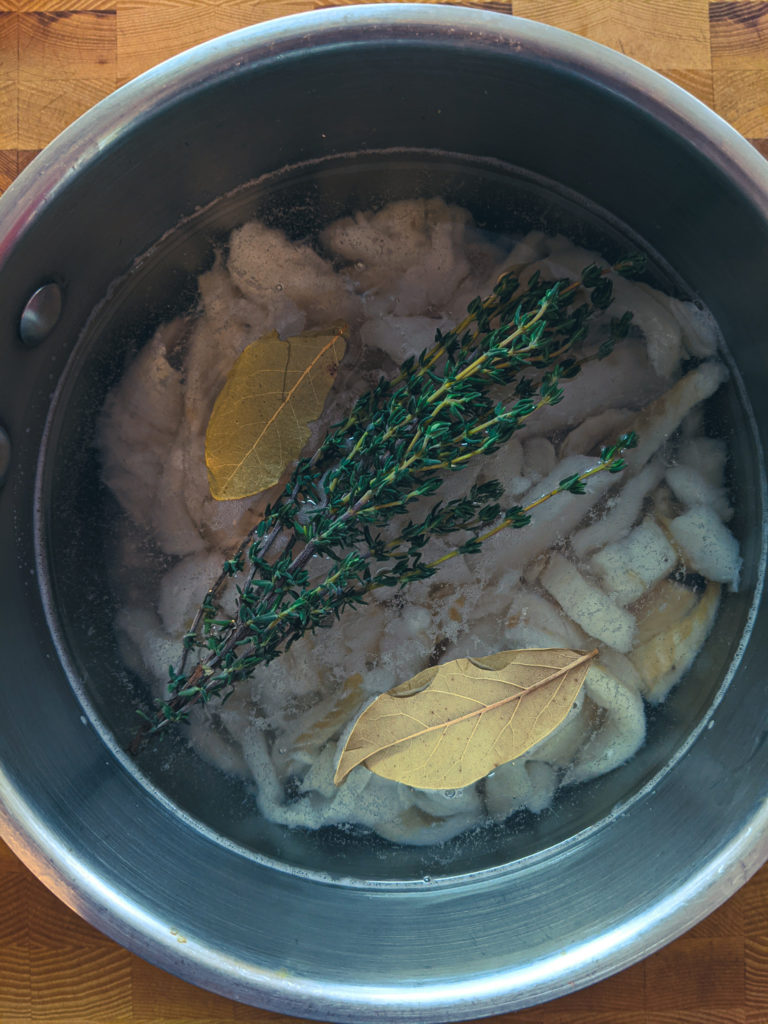Salt cod fish cakes are a versatile and delicious dish that can be enjoyed for both light lunches and filling brunches. This recipe is my personal best, and I am excited to share it with you. The flaky salt cod is paired with a perfect blend of lemon, thyme, parsley, and pepper, which provides a complementing flavour without overpowering the taste of the fish. Whether you’re an experienced home cook or a beginner, this recipe is easy to follow and guarantees great results. In this blog post, you’ll find detailed instructions and helpful tips to guide you through making the best salt cod fish cakes ever. So, let’s jump right in and get started on this delicious and satisfying dish.

What is Salt Cod?
Salt cod, also known as bacalao or bacalhau, is a traditional form of preserved fish used for centuries. The preservation process involves covering the fish in salt, which draws out the moisture and dries it, allowing it to be stored indefinitely. This method of preservation was commonly used during the days of long sea voyages before the advent of refrigeration or canning. Salt cod has a rich history and is a staple ingredient in many traditional cuisines, mainly Portuguese, Spanish, and Eastern Canadian cuisine.
Salt cod is available in various forms, including bits, fillets, or whole fish. For today’s recipe, we suggest using bits, which are readily available in most grocery stores. Additionally, salt cod is a versatile ingredient that can be used in many dishes, such as fish cakes, stews, soups, and more. It’s a great source of protein and packed with essential vitamins and minerals, which is why it has been a staple in the Mediterranean diet for centuries.

Preparing The Salt Cod
Soak The Cod
Salt cod, by definition, is salty, which is a result of the preservation process. However, to make it edible and to bring out its full flavour, it is important to remove some of the salt and rehydrate the fish. This process is known as soaking, and it is a crucial step when preparing salt cod.
To properly soak salt cod, start by rinsing the fish under cold running water to remove any excess salt on the exterior. Then, place the fish in a container and cover it with cold water. It is important to use cold water as it helps to keep the fish firm and preserve its texture. Next, place the container in the refrigerator and let it soak overnight. For best results, it is recommended to change the water at least once while the fish is soaking. This will help to remove any remaining salt and ensure that the fish is properly rehydrated.
Soaking salt cod not only helps to remove the excess salt but also helps to enhance the fish’s natural flavours and makes it more tender and moist. It’s also a critical step to follow when preparing any dish that calls for salt cod, whether it’s fish cakes, stews, soups, or any other traditional dishes.



Cooking Salt Cod
After the fish has been soaked, it’s time to cook it. Boiling the cod is an effective method to remove any remaining salt and also to infuse it with extra flavour. To begin, drain the soaking water from the cod and rinse it once again.
Place the cod in a pot, cover it with cold water and add a couple of bay leaves and a big sprig of thyme. The bay leaves and thyme impart a subtle and delicious flavour to the cod and help remove any remaining salt. Bring the contents of the pot to a boil over high heat, then turn the heat to low and simmer for about 5 minutes.
Once the cod is cooked, strain it and remove the thyme and bay leaves. The fish is now ready to be used for the fish cakes.




Making Salt Cod Fish Cakes
Onions
While the cod is cooking, prepare the onion. You’ll need about a cup of diced onion in total. Start by finely dicing one medium-sized onion. Also, chop up some thyme, about two teaspoons in total. This will add a subtle and delicious flavour to the fish cakes.
Put a small pot or pan on the stove on medium heat. Add a tablespoon of butter and a tablespoon of olive oil. Once the butter starts to foam, add the onions and thyme. Cook the onions for about three to four minutes or until they soften, turn translucent and start to slightly brown. Slightly browning the onions brings out the natural sweetness and enhances their flavour.
As you cook the onions, occasionally stir them to prevent burning. Slightly browned onions are a key ingredient in many dishes, and adding them to fish cakes will give your dish a unique and delicious flavour.



Assembling Salt Cod Fish Cakes
To make the fish cakes, start by putting the cooked cod and cooked onions in a medium mixing bowl. Add two cups of leftover mashed potatoes, two tablespoons of chopped parsley, a quarter teaspoon of black pepper, and the zest of one lemon. Parsley adds a fresh and herby note, the lemon zest provides a bright and tangy flavour, and the black pepper gives a nice kick of heat. These ingredients help to balance out the flavours of the fish and onions and provide a well-rounded taste.
With your hands or a wooden spoon, mix everything until it just comes together. The goal is to just combine the ingredients. It’s important not to over-mix the ingredients as it will cause the fish cakes to lose their delicate, flaky texture. Over-mixing causes the fish to release its moisture and bind together with the other ingredients, creating a gummy paste instead of a light and flaky fish cake. Additionally, over-mixing may lead to the fish cakes falling apart when they are cooked, so it’s important to handle the ingredients gently and mix them until they’re just combined.
You may also consider adding some additional ingredients like garlic, diced red pepper, or chopped olives to give the fish cakes more depth of flavour and make them more unique. Also, you can experiment with other herbs like dill or cilantro to give the fish cakes a different twist.





Forming The Fish Cakes
When forming the fish cakes, you can make them in different sizes depending on your preference. I prefer smaller fish cakes, so I measured mine with a quarter cup measure. However, if you prefer larger ones, you can use a half-cup measure or, for even bigger fish cakes, a full-cup measure. Ice cream scoops work well for this.
Simply measure out the mixture and form it into patties. You can cook the fish cakes right away or store them for later. They will last in the refrigerator for up to three days, and they can also be frozen for up to three months. Before cooking, chill the fish cakes in the fridge for 30 minutes to give them time to firm, making cooking easier. This is optional but highly recommended.


Cooking and Serving The Salt Cod Fish Cakes
To cook the fish cakes, heat a medium skillet over medium heat. Add a tablespoon of butter and a tablespoon of olive oil. Once the butter starts to foam, add the desired number of salt cod fish cakes to the pan. Cook the fish cakes for about three to four minutes per side or until golden brown and warm in the middle. Serve the fish cakes with a bit of salad and some tartar sauce or poached eggs.





The Wrap-Up
Cooking the fish cakes is a simple process that results in a delicious and crispy golden brown exterior and a warm and flaky interior. To cook the fish cakes, heat a medium skillet over medium heat. Add a tablespoon of butter and a tablespoon of olive oil. The combination of butter and oil creates a flavorful and rich base for the fish cakes to cook in and helps prevent sticking.
Once the butter starts to foam, add the desired number of salt cod fish cakes to the pan. Cook the fish cakes for about three to four minutes per side or until golden brown and warm in the middle. The fish cakes should be cooked through, and the internal temperature should reach at least 74°C (165°F) to ensure they are safe to eat.
When the fish cakes are ready, remove them from the pan and let them rest for a couple of minutes before serving. This will allow them to firm up and retain their shape.
Serve the fish cakes with a bit of salad and some tartar sauce or poached eggs. The salad provides a fresh and crunchy contrast to the fish cakes, while the tartar sauce or poached eggs adds a rich and creamy element to the dish. You can also serve the fish cakes with a side of roasted vegetables, mashed potatoes or even with a side of pasta or rice.
Subscribe now and never miss a delicious recipe! Put your email in the box below.
Ingredients
Cod
- 1 lb Salt Cod
- 2 bay leaves
- 1 sprig thyme
Onions
- 1 cup diced onion
- 1 tbsp butter
- 1 tbsp olive oil
- 2 tsp minced thyme
Other Ingredients
- 2 cups mashed potatoes
- 1 lemon, zest
- 1/4 tsp black pepper
- 2 tbsp chopped parsley
Instructions
Salt Cod
- Rinse the excess salt off the cod under cold running water.
- Put the fish in a container, cover it with cold water, and put it in the fridge for at least 12 hours or up to 24. For best results, change the water at least once.
- Drain the water off the fish and rinse it once again.
- Put the fish in a pot, cover it with cold water, and add 2 bay leaves and a big sprig of thyme.
- Bring the pot to a boil on high heat. Once it comes to a boil, turn the heat to low and simmer for 5 minutes.
- Drain the fish, and remove the bay leaves and thyme.
Onions
- Put the butter and olive oil in a small pot or pan on medium heat.
- Once the butter melts and starts to foam, add the onions and thyme.
- Cook the onions, stirring, for 3 to 5 minutes or until the onions soften, turn translucent and just start to brown.
Fish Cakes
- In a large mixing bowl, combine the cooked cod, cooked onions, mashed potatoes, lemon zest, parsley, and pepper. Mix just enough to bring everything together. You don't want to break the fish up too much.
- Measure the mixture into 1/4 cup portions for small cakes or 1/2 cup portions for larger ones. Form into fish cakes.
- Store the fishcakes in the fridge for up to three days or freeze them for up to three months.
- To cook the fishcakes, heat a medium frying pan over medium heat. Add 1 tbsp of butter and 1 tbsp of olive oil. Once the butter starts to foam, add 3 to 4 fishcakes to the pan. Cook for about 3 minutes per side or until golden brown and warm in the middle. Serve.



I never eat cod but make regular fish cakes with haddock. Would this recipe work with haddock, omitting the fish soaking?
Absolutely it would.
We have not eaten salt cod fish cakes in a couple of years, now seeing the recipe makes me want to make them this weekend.
That sounds like a good weekend project to me
great fish cakes have made them twice!!
Thank you Kim! I’m really happy to hear that you enjoy them. Thank you for letting me know
Cant wait to try this recipe! I noticed that there’s no egg in your recipe. Will this give a firmer fish cake? Mine have been too soft. I wonder if it’s the eggs that causes that to happen?
Usually, you would use the egg as a binder. I didn’t find that I need one when developing this recipe. It should only have a minor effect on the moisture content in the fishcake. Thank you for your comment.